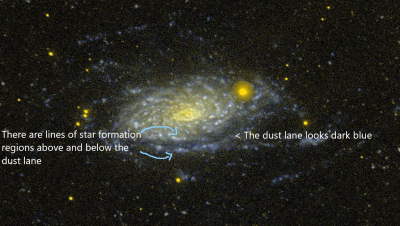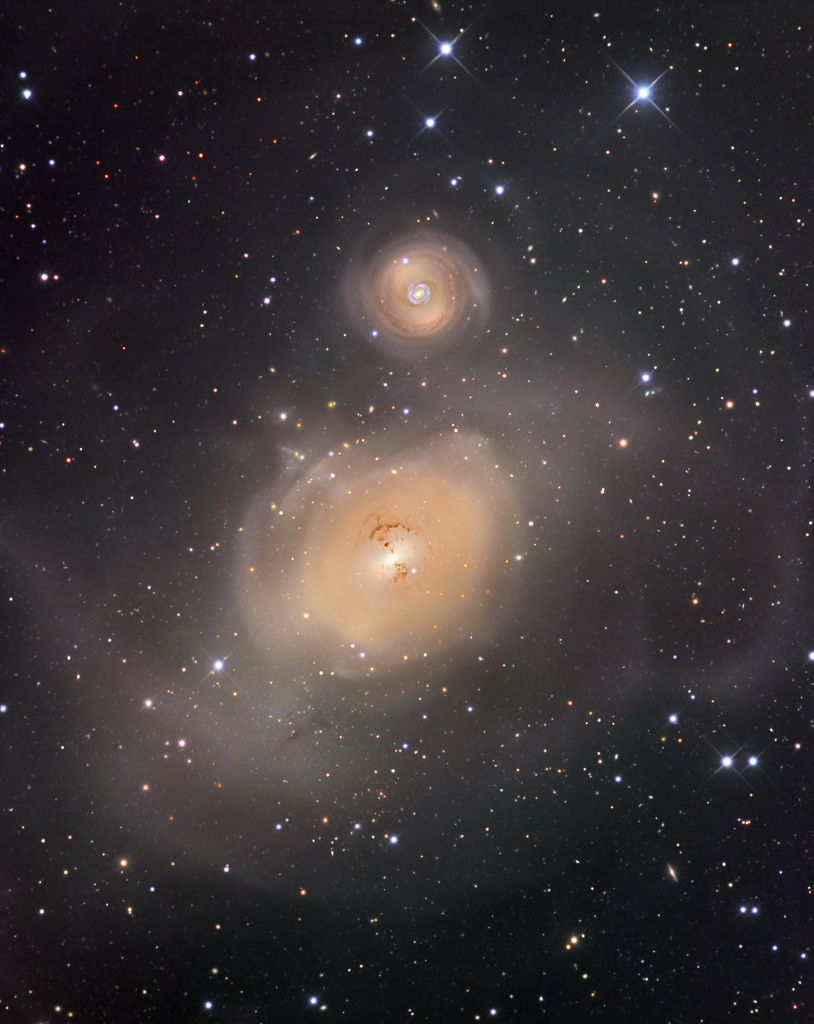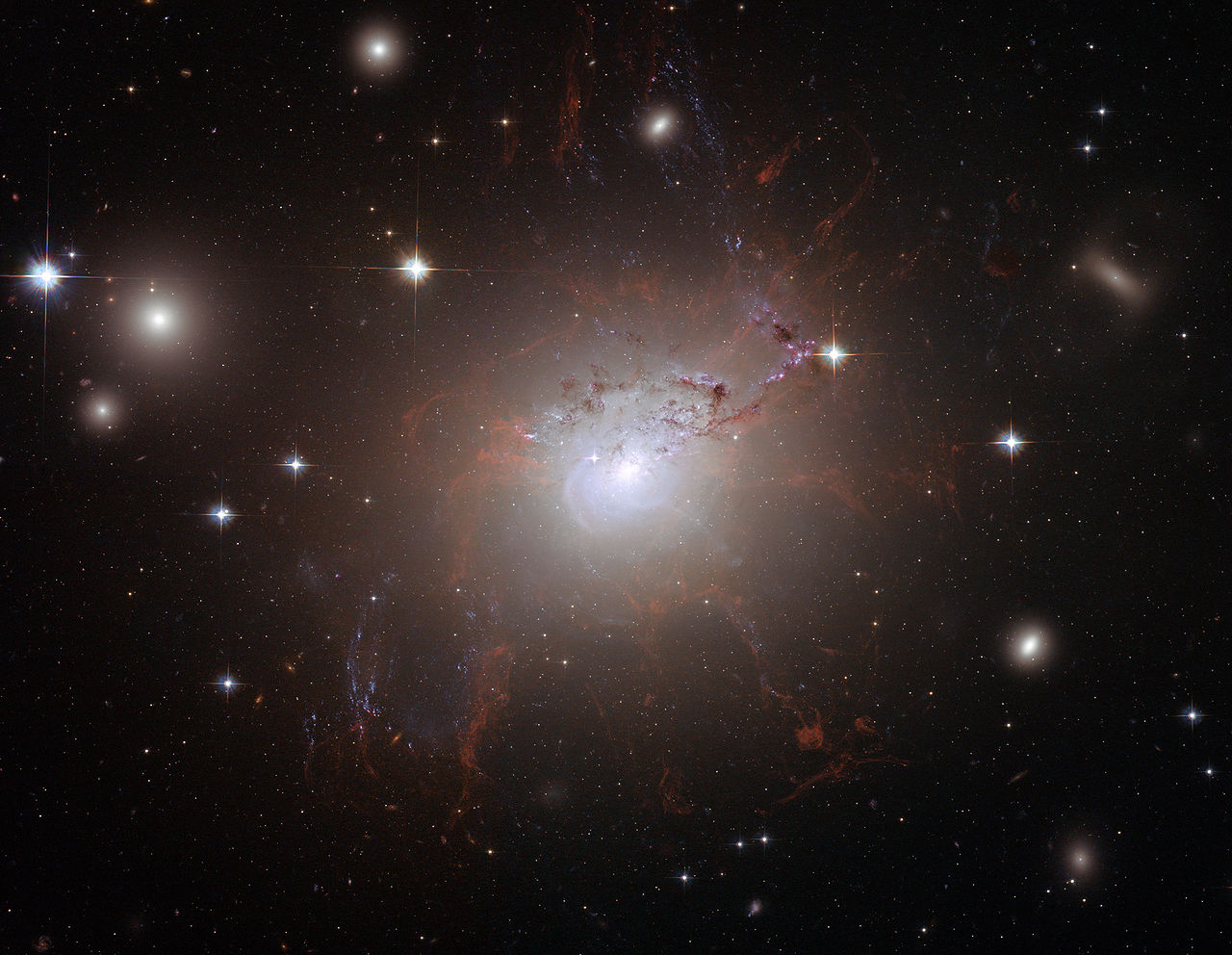Page 1 of 1
APOD: Curly Spiral Galaxy M63 (2023 May 19)
Posted: Fri May 19, 2023 4:05 am
by APOD Robot
 Curly Spiral Galaxy M63
Explanation:
Curly Spiral Galaxy M63
Explanation: A bright spiral galaxy of the northern sky,
Messier 63 is nearby, about 30 million light-years distant toward the loyal constellation Canes Venatici. Also cataloged as NGC 5055, the majestic
island universe is nearly 100,000 light-years across, about the size of our own
Milky Way. Its bright core
and majestic spiral arms lend the galaxy its popular name, The Sunflower Galaxy. This exceptionally deep exposure also follows faint, arcing star streams far into the galaxy's halo. Extending nearly 180,000 light-years from the galactic center, the star streams are likely remnants of
tidally disrupted satellites of M63. Other satellite galaxies of M63 can be spotted in
the remarkable wide-field image, including faint
dwarf galaxies, which could contribute to M63's star streams in the next few billion years.
Re: APOD: Curly Spiral Galaxy M63 (2023 May 19)
Posted: Fri May 19, 2023 7:10 am
by Ann
Curly Spiral Galaxy M63 (cropped image).
Image Credit & Copyright: Sophie Paulin, Jens Unger, Jakob Sahner
Interacting lenticular galaxy NGC 1316 with curly tidal tails.
Credit: I don't know.
M63 is surrounded by some impressive tidal structures. But other galaxies are too, as you can see in the picture of interacting lenticular galaxy NGC 1316. The tidal structures around NGC 1316 are so impressive that they make NGC 1316 look like a barred galaxy with a large ring and two spiral arms!
Let's have a look at the inner workings of M63 and NGC 1316:
My guess is that both M63 and NGC 1316 may have consumed a small satellite galaxy, and their meals have given them indigestion. M63, the spiral galaxy, "should" have had a more clearly defined inner spiral structure, and NGC 1316, the lenticular galaxy, "should" have had a purely yellow, dust-free appearance, if the incorporation of a satellite galaxy hadn't been so upsetting. And neither of them "should" have had these large surrounding tidal structures, if they hadn't eaten one of their small satellite galaxies! Or so I think anyway.
Of course, in the case of NGC 1316, it is clearly interacting with other galaxies too, including NGC 1317. Or is it? Note that NGC 1317 appears quite unaffected by the proximity(?) of NGC 1316, whereas NGC 1316 is "bleeding tidal tails" all over! And surely the dusty debris across the inner face of NGC 1316 wasn't caused by NGC 1317? So I really think that the messy appearance of NGC 1316 is a result of it having swallowed a satellite galaxy and wondering where its indigestion pills are!
Let's look at two elliptical galaxies that really ate more than they could chew:
What has happened to M63 is obviously not so violent. The satellite galaxy that merged with M63 must have been quite small, but still big enough to have created a real global galactic disturbance.
Take a look at M63 again and note the wiggly blue line at 3 o'clock. In the first picture I posted, I asked what that blue line is, but it is clearly just a long line of star formation. A "long" line is the word for it! It must be thousands of light-years long! And there is nothing like it anywhere else in M63.
To the left of the blue line of star formation is a very pronounced dust lane, which is light brown in color in the APOD. There is nothing like this dust lane anywhere else in M63.
Note to the upper right of the wiggly blue line a small, faint gray clump embedded in the "head" of a tidal tail or a dust lane. That thing could be an evaporating satellite galaxy, if you ask me.
Have we caught the culprit?
Ann
Re: APOD: Curly Spiral Galaxy M63 (2023 May 19)
Posted: Fri May 19, 2023 5:03 pm
by Cousin Ricky
I’ve never seen a photo of M63 this deep before!
Re: APOD: Curly Spiral Galaxy M63 (2023 May 19)
Posted: Fri May 19, 2023 5:16 pm
by Chris Peterson
Ann wrote: ↑Fri May 19, 2023 7:10 am
Take a look at M63 again and note the wiggly blue line at 3 o'clock. In the first picture I posted, I asked what that blue line is, but it is clearly just a long line of star formation. A "long" line is the word for it! It must be thousands of light-years long! And there is nothing like it anywhere else in M63.
To the left of the blue line of star formation is a very pronounced dust lane, which is light brown in color in the APOD. There is nothing like this dust lane anywhere else in M63.
Note to the upper right of the wiggly blue line a small, faint gray clump embedded in the "head" of a tidal tail or a dust lane. That thing could be an evaporating satellite galaxy, if you ask me.
Hmm. Here's an image I made of that galaxy, which just catches the region under discussion. It is much less deep (only about three hours of exposure), but arguably more accurate in its color. I think that we might be seeing a large clump of dust and gas, with some bright, but perhaps not terribly blue stars in it. Hard to say.
_
Re: APOD: Curly Spiral Galaxy M63 (2023 May 19)
Posted: Fri May 19, 2023 8:02 pm
by Ann
Chris Peterson wrote: ↑Fri May 19, 2023 5:16 pm
Ann wrote: ↑Fri May 19, 2023 7:10 am
Take a look at M63 again and note the wiggly blue line at 3 o'clock. In the first picture I posted, I asked what that blue line is, but it is clearly just a long line of star formation. A "long" line is the word for it! It must be thousands of light-years long! And there is nothing like it anywhere else in M63.
To the left of the blue line of star formation is a very pronounced dust lane, which is light brown in color in the APOD. There is nothing like this dust lane anywhere else in M63.
Note to the upper right of the wiggly blue line a small, faint gray clump embedded in the "head" of a tidal tail or a dust lane. That thing could be an evaporating satellite galaxy, if you ask me.
Hmm. Here's an image I made of that galaxy, which just catches the region under discussion. It is much less deep (only about three hours of exposure), but arguably more accurate in its color. I think that we might be seeing a large clump of dust and gas, with some bright, but perhaps not terribly blue stars in it. Hard to say.
_
M63.jpg
Note in this UV portrait of M63 that the wiggly blue line stands out well (at 3 o'clock). However, it is not as dominant as it should be if it was "radically bluer" than anything else in the outer disk or halo of M63.
Ann
Re: APOD: Curly Spiral Galaxy M63 (2023 May 19)
Posted: Fri May 19, 2023 9:15 pm
by orin stepanek
I can see why they call it Curly with the streaming around it!
I like the fact that it is about the size of the MW! gives a good reason
to study it! Might learn more about the MW that way!

Re: APOD: Curly Spiral Galaxy M63 (2023 May 19)
Posted: Fri May 19, 2023 10:25 pm
by Ed Siegel
What I see in this beautiful photo is an almost circular arc of stars that in the photo are about one diameter distant from the edge of M63. The arc is particularly prominent to the left starting at about 7 o'clock and extending to around 11:30. I wonder if it's me, or artifact or something actually cool.
Re: APOD: Curly Spiral Galaxy M63 (2023 May 19)
Posted: Sat May 20, 2023 12:15 am
by MarkBour
Ann wrote: ↑Fri May 19, 2023 7:10 am
...
Note to the upper right of the wiggly blue line a small, faint gray clump embedded in the "head" of a tidal tail or a dust lane. That thing could be an evaporating satellite galaxy, if you ask me.
Have we caught the culprit?
Ann
Ann, are you talking about this?
Re: APOD: Curly Spiral Galaxy M63 (2023 May 19)
Posted: Sat May 20, 2023 2:32 am
by Avalon
This galaxy looks like it has been in a washing machine, perhaps on the gentle cycle? How could small satellite galaxies cause so much disruption?
Re: APOD: Curly Spiral Galaxy M63 (2023 May 19)
Posted: Sat May 20, 2023 5:12 am
by Ann
MarkBour wrote: ↑Sat May 20, 2023 12:15 am
Ann wrote: ↑Fri May 19, 2023 7:10 am
...
Note to the upper right of the wiggly blue line a small, faint gray clump embedded in the "head" of a tidal tail or a dust lane. That thing could be an evaporating satellite galaxy, if you ask me.
Have we caught the culprit?
Ann
Ann, are you talking about this?
Indeed, Mark, that's exactly it.
Ann
Re: APOD: Curly Spiral Galaxy M63 (2023 May 19)
Posted: Sat May 20, 2023 8:07 pm
by johnnydeep
Ed Siegel wrote: ↑Fri May 19, 2023 10:25 pm
What I see in this beautiful photo is an almost circular arc of stars that in the photo are about one diameter distant from the edge of M63. The arc is particularly prominent to the left starting at about 7 o'clock and extending to around 11:30. I wonder if it's me, or artifact or something actually cool.
I see many arcs in this APOD, which are the various streamers of stars being talked about. Not sure which one you're referring to though.
Re: APOD: Curly Spiral Galaxy M63 (2023 May 19)
Posted: Sat May 20, 2023 10:39 pm
by VictorBorun
Ann wrote: ↑Fri May 19, 2023 7:10 am
To the left of the blue line of star formation is a very pronounced dust lane, which is light brown in color in the APOD. There is nothing like this dust lane anywhere else in M63.
Ann
My first guess is that a current and short-living dusty disk is at an angle with the main M63 gas and stellar disk; one half of that dusty disk is in front of the stellar disk, is visible in this APOD long exposure by backlight and is eclipsing M63. The other half is invisible to us.
Let me hang UF over APOD to see if it helps to see the shape of the dust…
...
Re: APOD: Curly Spiral Galaxy M63 (2023 May 19)
Posted: Sat May 20, 2023 11:18 pm
by VictorBorun
and IR over APOD…

- M63 2+.jpg (24.75 KiB) Viewed 4022 times
...
Re: APOD: Curly Spiral Galaxy M63 (2023 May 19)
Posted: Sat May 20, 2023 11:29 pm
by VictorBorun
and 3 hours of exposure by
Chris L Peterson over APOD…
...
I think here the dust (a half-disk of dust?) is most visible
Re: APOD: Curly Spiral Galaxy M63 (2023 May 19)
Posted: Sun May 21, 2023 5:23 am
by Ann
VictorBorun wrote: ↑Sat May 20, 2023 10:39 pm
Ann wrote: ↑Fri May 19, 2023 7:10 am
To the left of the blue line of star formation is a very pronounced dust lane, which is light brown in color in the APOD. There is nothing like this dust lane anywhere else in M63.
Ann
My first guess is that a current and short-living dusty disk is at an angle with the main M63 gas and stellar disk; one half of that dusty disk is in front of the stellar disk, is visible in this APOD long exposure by backlight and is eclipsing M63. The other half is invisible to us.
Let me hang UF over APOD to see if it helps to see the shape of the dust…
M63..jpgM63 3.jpg
...
Victor, I absolutely love your "image-hovers" where we can switch between two images at the same size and orientation. These images are so revealing!
Unlike you, I don't think that the prominent dust lane is short-lived, because it looks so substantial to me.
The dust lane may or may not be a site of star formation:
Victor, I shamelessly copied your way of creating an imaged-hover of Chris' image and the APOD!

Anyway. In Chris' fine image, it looks as if the dust lane may be a foreground object located in front of the starforming disk of M63. If so, the regions of star formation seen above and below the dust lane are just peeking out above and below the foreground curtain of dust, and the dust lane has nothing to do with their presence. This hypothesis is strengthened by the fact that the dust lane does not look very prominent at all in the Spitzer infrared image.
Note however that the dust lane looks dark blue in the GALEX UV image, as if it contained a large number of small hot stars. Of course, it is equally possible that the dust lane just serves as a reflection nebula scattering UV light from sources behind it!
But take a look at another picture of Centaurus A to see why I'm talking about possible star formation along the edge of the dust lane of M63. It is exactly that sort of thing that we see along the the edge of the dust lane of Centaurus A:
Centaurus A. Credit: SSRO/PROMPT/CTIO, Chile;
Processed by Mark Hanson
Of course the dust lane of M63 is in no way comparable to the magnificent and broken dust lane of Centaurus A. The comparison is interesting all the same, I think.
Ann
Re: APOD: Curly Spiral Galaxy M63 (2023 May 19)
Posted: Sun May 21, 2023 7:47 am
by VictorBorun
Ann wrote: ↑Sun May 21, 2023 5:23 am
The dust lane may or may not be a site of star formation:

Ann
now I see that, too, in a lane beyond the disk of M63:
...
Re: APOD: Curly Spiral Galaxy M63 (2023 May 19)
Posted: Tue May 23, 2023 4:31 pm
by Ann
VictorBorun wrote: ↑Sun May 21, 2023 7:47 am
Ann wrote: ↑Sun May 21, 2023 5:23 am
The dust lane may or may not be a site of star formation:

Ann
now I see that, too, in a lane beyond the disk of M63:
M63 5-.jpgM63 5.jpg
...
I should have answered you before. There are indeed several young (or young-ish) stars along that dotted line below the visible disk of M63. (When I say that the stars can be young-ish, I mean that GALEX probably reacted to stars like Sirius and Vega, and they can be a few hundred million years old. Then again, it is also possible that the stars along that line are much younger and also hotter and more massive.)
So, yes. There are indeed young stars beyond the visible disk of M63.
Ann
 Curly Spiral Galaxy M63
Curly Spiral Galaxy M63




